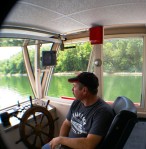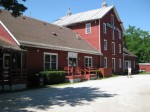Flapjacks and Fall Leaves
-

- The only evidence of the mill wheel is the water pouring out of the basement in the the Litte Miami River Gorge
The waters of the Little Miami River have been supplying power to mills in Clifton, near Dayton, since 1802. The Clifton Mill is considered to be one of the largest water-powered grist mills still operating in America.
While they have a traditional water wheel that turns near the first floor of the mill, that one is just for tourists. The real work is done by a millrace forcing water into a turbine in the basement of the mill. The only evidence of its existence is the water pouring from the side of the building back into the Little Miami River Gorge.
While the Clifton Mill attracts most visitors during the Christmas season when the mill and the gorge are illuminated with millions of colored lights, it is a great place to visit in other seasons, especially in the autumn.
The mill today only produces small amounts of flour for demonstration purposes during tours of the historic structure. The flour they sell to visitors is actually made to their specifications by other nearby commercial mills.
My favorite spot is in the Millrace Restaurant located inside the mill, overlooking the Little Miami River Gorge, where one of the specialties is “man-hole cover” size pancakes. While they really aren’t quite that big they do measure 11 to 12 inches across and are nearly an inch thick. The two pancakes they serve you contain enough batter to probably make a stack six inches high of normal-sized pancakes. In fact, the cakes are so big that they fill the plate and there is no room for the syrup and butter to go anywhere except off the plate and onto the table……….
….You can read the rest of this story in the Saturday, September 22nd edition of the Plain Dealer or on their website at www.cleveland.com
Enjoying Fall Foliage on a Green Sternwheeler
-

- Captain Don Stanford says the cooking oil powered ship smells like something good being cooked on a grill
-

- Owner and Captain of the Valley Gem, Jason Sands, says the conversion to cooking oil fuel helps keep operating costs low on the boat.
The forty-year old Marietta tourist icon “The Valley Gem”, an authentic Ohio River Sternwheeler tourist boat, is celebrating four decades on the river by going green.
Instead of burning smelly diesel fuel they are being propelled down the river with used cooking oil.
According to Co-captain Don Sanford, “It smells very pleasant, very much like somebody is grilling something good.”
The 303-passenger sternwheeler made the conversion from expensive diesel fuel to used cooking oil last summer. According to owner and Captain Jason Sands, “We had been thinking of doing this for about four years.”
The Valley Gem has been taking tourists up and down parts of the Ohio and Muskingum Rivers near Marietta since 1972. The first, smaller, Valley Gem was replaced by the present 300-plus capacity sternwheeler in 1989.
“Back in the 90’s diesel fuel cost us 65-70 cents a gallon” Says Captain Sands, “Now it costs us an average of $3.20 a gallon when we buy large amounts.” Since the boat consumes about a thousand gallons of fuel each month, that was the incentive that prompted Sands and Sanford to construct a bio-diesel processing facility and start begging for used cooking oil from restaurant facilities around the town of Marietta.
“Many restaurants are happy to have someone haul away their used cooking oil, so we get the oil for free and it costs us about 80 cents a gallon to process it so we can use it as fuel.”
The used oil that once was used to cook chicken, fish and fries has proved so successful that both Sands and Sanford have purchased diesel-powered cars and trucks for their personal use and also run them on the converted cooking oil.
“Our passengers have benefited from the conversion to cooking oil,” Sands said, “It has enabled us to keep prices lower by eliminating our dependence on expensive diesel fuel.”
The Valley Gem is gearing up for its most popular cruises of the season, the fall foliage trips on the Ohio and Muskingum Rivers, including some special longer trips slated for this September and October….
….You can read the rest of this story in the Saturday, August 25th edition of the Plain Dealer or on their website: www.cleveland.com
A Trip To Lollipop Land
-

- The Candy Store at the Spangler Candy Company where you can buy a bag of just one flavor of Lollipops
Our Ohio Road Trip this week is to Bryan, Ohio, called “The Fountain City”, because they once had so many artesian wells that bubbled out of the earth. In fact today the city water is provided from seven artesian wells and residents brag about the taste of their city water.,
Perhaps this pure water supply was one of the reasons that brought the Spangler Candy Company to Bryan. While you may not be familiar with Spangler, one of their products, Dum-Dum Lollipops, is known the world over.
Lollipops are big business; the Spangler Bryan plant is huge. They make 2.3 billion Dum Dum Lollipops, that’s billion with a “b”, each year. There are sixteen flavors and new ones are constantly being developed in their laboratory kitchen here at the factory. Some of those that didn’t make the cut were bacon and pepperoni. They encourage visitors to their company museum/store to sample and give their opinion about some of the new flavors.
Spanglers 500-thousand square feet of buildings cover several city-blocks and with over 425 employees it is one of the largest employers in the community. They not only make lollipops, but also some other icons of the candy world like circus peanuts, those little orange marshmallow creations that look like peanuts still in the shell, and Saf-T-Pop, another lollipop with a handle in the shape of a loop for tiny hands, and they are also America’s largest producer of candy canes.
It’s the kind of place where workers seem to pass their job down from one generation to the next. From company CEO, Dean Spangler, who is the third generation to run this family-owned business to Mattea St. John, whose great-grandmother once worked on the candy line at the factory, just as Mattea did when she was in college. Today Mattea is the E-Commerce Manager for Spangler.
Spangler Candy is also one of the few factories in Ohio that still give tours. They have two miniature Dum Dum Trolleys that run every half-hour during the day taking visitors to the factory on a ride through parts of the plant, packing room and warehouse where tons of lollipops are stacked waiting to be shipped all over the world
…..You can read the rest of this story in the Saturday, July 28, 2012 edition of the Plain Dealer or on their website at WWW.Cleveland.com
Flying High In The Summer Skies
-

- Chief Flight Instructor Dave Nuss prepares to take Bonnie Zurcher for a ride in sleek two-seater sailplane
On Thursday evenings and weekends, if you look to the skies over Middlefield in Geauga County, you may spot a sleek, silent aircraft soaring like a bird. It is not an airplane because it has no motor; it is a sailplane. It relies on the winds and columns of air called thermals to keep it flying.
It was the predecessor of these sailplanes, early gliders, which first taught humankind to fly, long before the Wright Brothers attached a motor to the fragile wings and body of a glider and began the era of powered flight.
It was fifty years ago a group of glider flying enthusiasts gathered at the TAPCO Company in Cleveland to organize the Cleveland Soaring Society.
Soaring is the sport of flying a full-size aircraft with no motor. The craft gets airborne by being towed by a long rope attached to a powered airplane to a height of several thousand feet and then the cord is released and the sailplane, depending on the skill of the pilot and the weather conditions, can soar like a giant graceful hawk for an hour or more. However most flights are usually about twenty minutes long before the aircraft glides gracefully back to earth, landing on its single wheel.
Club secretary Dave Mills told me that although the Cleveland Soaring Society has had many homes over the last half-century, the place they have repeatedly come back to is the present home base, the Geauga County Airport in Middlefield. The Cleveland Soaring Society’s members hail from all over northeast Ohio and western Pennsylvania.
There, on Thursday evenings and Saturday and Sundays, weather permitting, you will find a dozen or more members of the club and their families gathering to assist getting the sailplanes into the air. Sailplanes can take off from paved runways or a grassy field. It takes a crew of several people to launch one of the aircraft. A pilot is needed to fly the tow-plane. One or two field personnel then attach the rope from the airplane to the glider. A wing-runner has to lift the wing and hold it steady as he trots along while the glider is towed down the runway until it gathers sufficient wind under its wings for a take-off. Then it is up to the pilot of the sailplane to fly just a bit above the tow-rope in order to let the tow-plane safely pull them up to the altitude agreed upon before take-off which is usually three to five thousand feet. When they reach altitude the sailplane pilot disconnects from the tow-rope and the soaring-like-a-bird part of the flight begins. It is nearly silent in the craft. All you hear is the hushed whisper of wind passing over the glider. While the sailplane is capable of doing loops and steep spirals, the flight is usually a series of gentle turns and breathtaking views of the earth below.
Current society president and chief flight instructor Dave Nuss, told me that visitors are welcome at the airport when the club members are flying. There is no admission charge. Rides with an instructor in the sailplane are available to the public for $100…
….you can read the rest of this story in the Saturday, June 23, 2012 edition of the Plain Dealer or on their website at WWW. Cleveland.com
By the way. We have learned there are two web sites that direct you to the Cleveland Soaring Society. The one listed in the paper says it is “under construction” A soaring society official told me Sunday that the correct website is: www.clevelandsoaring.org
A Hallowed Place in Medina County
-

- Marine Corps Veteran Ted Driscol of Amherst stands in front of one of the many memorial stones in the Western Reserve National Cemetery
-

- A bronze statue of a veteran stands in eternal salute at the entrance to Western Reserve National Cemetery
The simple flat tombstones stand like soldiers in formation. Row after row, stretching to the horizon in this Medina County farm land. This is the Ohio Western Reserve National Cemetery.
Over 19,000 members of the armed services and veterans have already been laid to rest here since the cemetery was dedicated in the year 2000. Sean Baumgartner, The cemetery director, told me that they average 8 funerals a day, Monday thru Friday.
The cemetery owns 273 acres with less than a third of the land developed so far for burials. Baumgartner says there are approximately 540 thousand eligible veterans of all U. S. Armed Forces that live in northeast Ohio that may choose to be buried here in this newest of National Cemeteries.
The Medina County location near Rittman is the 119th National Cemetery to be created in the United States and is one of two located in Ohio. The other is in Dayton.
It is a sobering sight as you drive through the gate and onto the winding streets of this hallowed ground. At a turn in the road, near the visitor center, there is a life-size bronze statue of a veteran, dressed in a civilian suit and wearing a service cap. The bronze veteran holds an eternal salute to honor the service members and veterans who are brought here for burial.
The campaign for the statue was led by Frank Aleksandrowicz, 92, of Bay Village, Ohio. Aleksandrowicz is a veteran of both World War II and the Korean War. In fact, when the donations for the statue fell short, Aleksandrowicz dug into his own savings for more than 25 thousand dollars to make sure the 55 thousand dollar goal would be reached so Sculptor David Deming of Cleveland could finish the six foot tall bronze statue. It was completed and erected in 2008. It is presently the only statue permitted in the cemetery.
In a grove of trees at the edge of the rows of tombstones is a memorial walk that is literally filled with stone memorials placed there by veteran’s organization and fraternal groups commemorating various military services and individual regiments mostly of twentieth century wars. With over 120 stones it is believed to be the largest collection of such memorials in any national cemetery.
…you can read the rest of the story in the Saturday, May 26 edition of the Plain Dealer or on line at their website, WWW.cleveland.com
A Visit To The Shelby Mall
-

- Jennifer Arms, daughter of the owner, stands in rope department with hawser big enough to dock a battleship
First off, the “Shelby Mall” is not a mall. It is a huge surplus store. You might say a surplus store on steroids. It is a place you can buy everything from a surplus 2 and a ½ ton military troop carrier to new decorations for your home. There are aisles and aisles of parts for lawnmowers, automotive supplies, camping equipment, house wares, nuts, bolts, rope, garden supplies and, of course, military surplus.
Jennifer Arms, the owner’s daughter, laughs and says, “The real name is Glen’s Surplus, but our customers about ten of 15 years ago started calling it, “The Shelby Mall” and the name just sort of stuck. Lawnmowers are really our bread and butter. About half of our business is lawnmower repair parts.” Jennifer says they have the parts for just about any lawnmower that was ever made. In fact they have one room just dedicated to lawnmower blades and another room for wheels for lawnmowers.
Located in a century-old former manufacturing plant near downtown Shelby, the sales floor covers over thirty-thousand square feet.
“We have become a destination for tourists.” Says Jennifer Arms, “First time visitors come in the front door and just stop and stare because there is just so much stuff.”
There is a room filled from floor to ceiling with military surplus and law enforcement equipment, both new and used. There are new field uniforms and flags, used parachutes and field generators. From a basket full of practice hand grenades to camouflage coveralls, known as “Ghillie Suits,” that give the wearer the appearance of a Sasquatch. They also buy back personal uniforms and military gear from returning soldiers. Jennifer laughs and says, “The one thing I won’t buy though is used socks and underwear.” Outside the store are row upon row of surplus military trucks and vehicles, still wearing their camouflage paint. All of them are for sale.
But it is not just military surplus. They buy and sell just about anything that is on the surplus market. . Jennifer says, “We have been told that we have the largest selection of wall-paper in a 150 mile radius.”
Over the years they have sold medical equipment for blood transfusions and even a gynecologist’s examination table. The most unusual item they sell right now is unused, surplus body bags. “Hunters and campers buy them because they are waterproof and use them for a variety of purposes.” Jennifer said.
……you can read the entire story in the Saturday, April 28, 2012 edition of the Plain Dealer or on-line at their website: www.cleveland.com
Watching The Birds Return To Ohio
This week in my monthly Ohio Road Trip in the Plain Dealer we travel to Ottawa County…here’s an excerpt:
It’s that time of year when bird-watchers start flocking to northwest Ohio for the return of hundreds of different kinds of birds that either make Ohio home or are just passing through on their way to Canada.
Magee Marsh, two-thousand-acres spread across the shore of Lake Erie is seventeen miles west of Port Clinton and is operated by the Ohio Department of Natural Resources, Division of Wildlife. It is considered one of the top spots in North America to bird-watch. It’s located on one of the major north-south migratory paths where millions of birds funnel through each spring and summer and it is a natural resting spot for the birds before they start the long flight over Lake Erie to their destination in Canada.
How popular is birding? Just ask Mary Warren, Naturalist at the Magee Marsh, “Last year we had 50 thousand visitors from 44 states and five foreign countries.” She says it usually starts in late March and builds through April and reaches the peak in May as the warblers return. “There are 37 varieties of warblers; they are tiny birds, very colorful and very fast.”
On your way to, or from a birding expedition along Lake Erie’s shore you can also stop for a really big ice cream cone at Toft’s Dairy in Sandusky. …..You can read the whole story in the March 24th edition of the Plain Dealer or on their website:www.cleveland.com









































